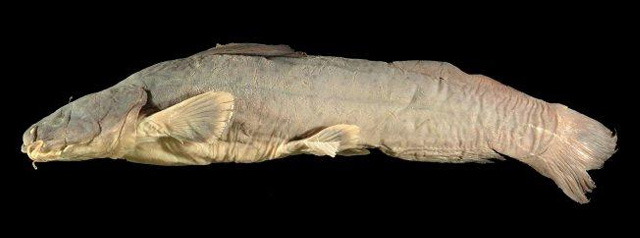| Lacantuniidae (Chiapas catfishes) |
| 42.7 cm SL (male/unsexed); 40.6 cm SL (female) |
|
pelagic; freshwater; depth range 0 - 18 m |
| North America: Mexico. |
|
Dorsal spines (total): 2-2; Dorsal soft rays (total): 8-10; Anal spines: 0-0. This species is distinguished from all other siluriforms by the following uniquely derived and anatomically complex characteristics: fifth infraorbital bone relatively wide and thick-walled, boomerang-shaped and anteriorly convex, and remote from a markedly prominent sphenotic process; the lateral margin of skull thickened along frontal bone and adjacent parts of lateral ethmoid and sphenotic bones at origins of much enlarged adductor mandibulae and levator arcus palatini muscles, otherwise the skull roof medial to muscle origins severely constricted, flat, lacking crests and fossae; a pair of cone-shaped "pseudo-pharyngobranchial" bones at anterior tips of enlarged accessory cartilages medial to first and second epibranchials; a hypertrophied, axe-shaped uncinate process on third epibranchial; gas bladder with paired spherical, unencapsulated diverticulae protruding from anterodorsal wall (Ref. 54757). |
| Inhabits deep river channels and pools with rocks and strong eddy currents. sometimes taken in stream mouths; collected in both high and low water seasons, and generally during the night. Food include fishes, crabs, prawns, and large and tough seeds (Ref. 54757). |
|
Vulnerable (VU); Date assessed: 01 March 2018 (D2) Ref. (130435)
|
| harmless |
Source and more info: www.fishbase.org. For personal, classroom, and other internal use only. Not for publication.
